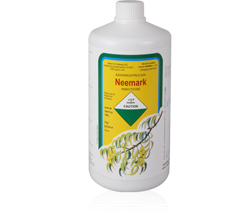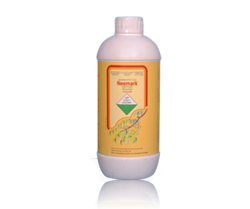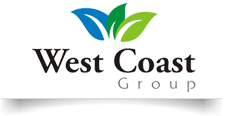Neemark® - Insect Anti Feedant/Repellant
 |
Insects cause major damage especially to high yielding varieties of crops. Necessary to reduce insect damage but if we can do so without use of toxic products, it is environmentally ideal.
What is Neemark?
Neemark is the extract of natural neem and contains triterpenoids & azadirachtin which are very effective against insects & yet are safe to human beings and animals.
Mode of action of Neemark:
- Anti-Feedant - Insects lose their appetite
- Repellant - Drives away the insects
- Growth regulatory- Larvae do not develop into full
grown adults - Ovipositor & ovicidal - Deposition & hatching of eggs reduced
- Safe to predators and parasites - Protects beautiful insects and
keeps population of harmful insects under control
Uses:
-
Totally bio-degradable
- Effective against wide range of insects
- Safe to the environment
- Cost effective over conventional pesticides
Dosage and recommendations of Neemark:
- Low volume spray: Spray 1 to 1.5 litres of Neemarkper acre.
- High volume spray: Spray @ 5ml Neemark per litre water and cover the entire foliage
- Tank mix: Along with standard dose of insecticides or fungicide, mix 3 ml of Neemark
per litre of spray solution.
Cropwise recommendations for pest management
- Cotton: Following insects are damaging cotton crops
Heliothis, larvae, bollworms - Spray Neemark starting from 45 days of planting at bi-weekly interval.
White fly - spray Neemark to prevent build up of white fly eggs and pupae. Nymphs should be controlled
at an early stage. Best results are obtained if Neemark is sprayed during oviposition time.
Spodoptera - spray Neemark at early season to prevent build up of spodoptera sucking pest - spray
of Neemark before flowering - Rice / paddy: Two or three sprays of Neemark will ffectively control pests like brown leaf hopper,
green leaf hopper, leaf hoppers and stem borers - Citrus: Citrus blackfly, aleurocanthus woglumi can be controlled by bi-weekly spray of Neemark
- Cabbage: Diamond back moth damages cabbage crop to a great extent and can be controlled effectively by using Neemark.
- Vegetables: Bi-weekly application of Neemark can effectively control all types of insects
- Pulses: Neemark is effective against gram pod borer, pea semilooper, aphids, whiteflies tur caterpillar
- Jujuba (ber): During winter months, fruit fly is active ;spray Neemark twice during his season.
- Grapes: For control of flea beetle, scales, thrips and jassids, spray Neemark from october to march
at monthly intervals. - Mango: Hopper is the main pest. Spray Neemark from november to february to
keep hopper under control. - Apples: For prevention of fruit borers, fruit flies, apple wolly aphids and apple mealy bugs.
- Melons & curcurbits: For prevention of fruit-fly, caterpillarsand beetles spray at fortnightly intervals.
- Pomegranate: To prevent anar butterfly from laying eggs on flowers and young fruits, spraying at
flowering time. - Sapota: For taking care of chikoo moth. Fruit flies and thrips spray Neemark regularly
- Chilies: To take care of damage of thrips, pod borers, caterpillars and aphids spray
Neemark every fortnight - Tomato: For control of leaf miner, caterpillar, jassids, beetles and whiteflies spray every 15 days
with Neemark. - coffee: Green and red bugs, shot hole borers, thrips and miners attack the plants and berries.
Spray Neemark from may onwards till the harvest. - Tea: Tea mosquito multiplication can be stopped by Neemark spray on tea..
- Onion: For control of thrips and maggots, spray Neemark every 15 days.
Application: during winter give Neemark spray to ovicidal action against the spring damage.


